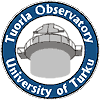|
Recent research highlights
 Dark energy
Dark energy
28th June 2004 ·
New cosmic force nearer than we think?
|
 100 BL Lacs
100 BL Lacs
2nd February 2004 ·
Galaxies show much of a muchness
|
 Rise and rise of He
Rise and rise of He
3rd March 2003 ·
Measuring the amount of Helium in the cosmos
|
|
Telescopes and Instrumentation
|
The Tuorla 1 m telescope was used for quasar monitoring
on most clear nights. Nearly 1800 pictures were
obtained. The 70 cm Schmidt telescope and the 60 cm
reflector were used mainly for studies of variable
stars.
The 70 cm Schmidt telescope was also used by Lehto and
Katajainen for obtaining public-relation images of
extended deepsky objects and comets.
MAGIC collaboration
The MAGIC telescope (Major Atmospheric Gamma-ray Imaging
Cherenkov telescope;
http://hegra1.mppmu.mpg.de/MAGICWeb/) is an
atmospheric imaging Cherenkov telescope designed to
detect cosmic gamma-ray photons (E = 30 GeV - 1
TeV). The 17-metre telescope is located on La Palma,
Canary Islands, Spain and it is run by the
MAGIC-collaboration that includes 18 (mostly European)
institutes. The inauguration was held on La Palma on
10th October 2003 with Aimo Sillanpää
representing Tuorla Observatory at the celebration.
First light was obtained in June 2003. Since then the
telescope has been in commissioning phase and has taken
calibration data on the Crab nebula and also observed
the blazar Markarian 421.
The main contribution of Tuorla Observatory to the MAGIC
collaboration is the use of the 60 cm optical telescope
on La Palma in connection with MAGIC observations. When
MAGIC becomes fully operational we will be able to
obtain for the first time truly simultaneous optical and
gamma-ray observations. We have successfully been using
the 60 cm telescope remotely from Tuorla since autumn
2003. Work on making the telescope fully automatic is
in progress.
|
|
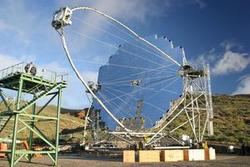
The MAGIC telescope at La Palma, which
obtained "first-light" in late 2003. Tuorla is a full-member of the project,
and will be providing simultaneous optical data with the Royal Swedish Academy's
60 cm telescope sited nearby.
|
|
|
Dynamics
|
|
Three-body problem
Mauri Valtonen has spent much of the year writing two
textbooks: "Three-body Astrophysics" with Hannu
Karttunen, and "Cosmology: Foundations and Frontiers"
with Arthur Chernin and Gene Byrd (University of
Alabama). Some of the research related to these books
has also appeared or submitted to print. A study of the
influence of the total angular momentum on the
three-body break-up was completed with the
St. Petersburg group (Victor Orlov and Alexei Rubinov)
and Alexandre Mylläri. Some of the results were
reported in an invited talk in the meeting on Order and
Chaos in Stellar and Planetary Systems in St. Petersburg
in August. The relevant distributions of the three-body
break-up have been derived from the principle of
chaoticity and have been confirmed by computer
experiments. This confirms the conjecture of Henri
Poincare from one hundred years ago that the three-body
system is basically chaotic even though islands of order
also appear.
One of the major applications of the three-body problem
appears in the study of binary and triple stars,
concerning their role in the evolution of star
clusters. This work was reported in an invited talk in
the meeting "Environment and Evolution of Binary and
Multiple Stars" in Merida, Mexico, in February. The
principle of chaoticity can be used to derive
cross-sections in three-body scattering which then lead
to evolutionary rates and properties of the binary
population in star clusters.
Few-body problem
Seppo Mikkola has continued studies on the few-body
problem applied mainly to the solar system. In
collaboration with Wiegert, Innanen and Huang he has
studied the dynamics of Pluto and the plutinos. Another
application was the dynamics of selected interesting
asteroids such as: the Neptune Trojan 2001 QR322 (paper
MNRAS 347, 2004), a Venus quasi-satellite 2002 VE68 and
an Earth quasi-satellite 2003 YN107 (papers
submitted). This research was in collaboration with
Brasser, Innanen, Wieger, Connors, Chodas and Huang.
Mikkola also studied spacecraft attitude dynamics
(numerical methods) in collaboration with the Surrey
Space Centre researchers Palmer and Hashida. New
composite and energy-preserving-implicit, methods were
invented.
Mikkola also gave an invited talk in JENAM20003
conference in Budapest on 'Co-orbitals of terrestrial
planets'. He visited the Max Planck Institute fur
Astronomy (MPIA) and the Astronomishes Recheninstitute
(ARI), Heidelberg (for a week) giving several invited
lectures on numerical few-body dynamics.
Extrasolar planets
Drs. Liyong Zhou, Harry Lehto and Jia-Qing Zheng in
collaboration with Yi-Sui Sun from Nanjing University
have carried studies on the extrasolar planetary system
55 Cancri. Three planets have been detected by other
research groups in this system. The two inner planets
appear to be trapped in a 3:1 mean motion resonance. By
developing new theoretical and computational analysis
tools Zhou et al. confirm the reality of such a resonance
in this very system. The implication of this resonance
to the stability of orbits of earth-like planets will be
investigated in further studies.
|
|
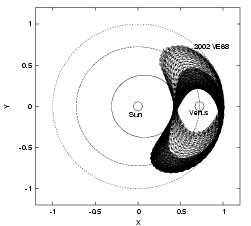
The motion of the Venus quasi-satellite 2002 VE68 for
the next 150 years. The coordinate system rotates with
Venus. Orbits of Mercury, Venus and Earth are also
(schematically) illustrated.
|
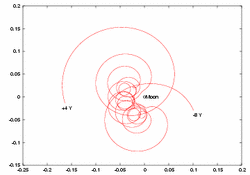
Motion of the temporary Earth quasi-satellite 2003
YN107 in geocentric coordinates. This asteroid became orbitally trapped
near the Earth about 8 years ago and will stay in
such an orbit for about four more years. The tiny circle
represents Moon's orbit around the Earth. Larger image
|
|
|
Cosmology
|
|
Local Hubble flow
In the area of cosmology, Valtonen was involved in the
study of the very local Hubble flow and its consequences
to the models of the Universe. Here the collaboration is
with the groups from the Special astrophysical
observatory in South Russia (Igor Karachentsev and
Dimitri Makarov) and from Moscow University (Valentin
Dolgachev and Ludmila Domozhilova) as well as with
Arthur Chernin. This work follows from an attempt to
secure a European Union grant for the detection of dark
energy of the Universe in local measurements. The
application failed, probably because the concept of dark
energy was not familiar among European astronomers at
the time. Anyhow, the work went on with a smaller
research team and more slowly than intended, and it has
now provided the third, independent, verification of the
dark energy, in addition to the American WMAP satellite
data and the results of the two (Anglo-Australian and
American) supernova teams. It was also demonstrated
that the concept of Little Bang, an initial chaotic
state of the Local group of galaxies, is quite relevant
in the dark energy cosmologies. This concept was
introduced by Valtonen and colleages about ten years
ago.
Large scale structure of the Universe
During 2003 Pekka Heinämäki and his
collaborators from Tartu Observatory cosmology group;
Jaan Einasto, Enn Saar, Maret Einasto, Mirt Gramann,
Gert Huts, Ivan Suhhonenko, continued their studies with
large scale structure of the universe and cosmological
N-body simulations.
In the recent papers (2003) they calculated and used the
density field of the Las Campanas Redshift Survey (LCRS)
and Sloan Digital Sky Survey (LDSS) to find clusters and
superclusters of galaxies and investigate their
properties. Using previous surveys and numerical N-body
simulations they studied also the mass function of the
loose groups of galaxies and environmental enhancement
of loose groups around rich cluster of galaxies.
Physical interpretation of the results found in previous
papers needs theoretical studies and numerical
simulations and it is planned to address these issues in
more detail in forthcoming papers.
Using the MLAPM (Multi Level Adaptive Particle Mesh),
development of the so called light-cone simulations was
started. While recent and forthcoming observations
extend deeper and deeper (e.g. SDSS, 2dF, DEEP2)
forthcoming influence of the evolutionary effects are
more prominent in surveys. Light cone simulations are
needed to mimic such observational data. This subject is
computational challenge and there were several
methodological questions which have to be solved. Very
few such simulations are done in cosmology before.
Methodological questions related to the light-cone
simulations have now been solved and calculations
started.
This work complements also the Planck related work of
the group. Last summer 2003 in working group 5
(Clusters distribution, Evolution, and Motion:
Large-Scale Structure Simulations) meeting, the group
announced that developing MLAPM (Multi Level Adaptive
Particle Mesh) light-cone simulations (mock catalogs)
would be one of their contributions to the Planck
project.
One of the plans for the year 2003 was to have a
post-doctoral fellow from the Tartu Observatory to the
Tuorla Observatory. This was realised, when Ph.D. Ivan
Suhhonenko started his work (in the cosmology group) in
Tuorla Observatory at the beginning of November 2003.
|
|
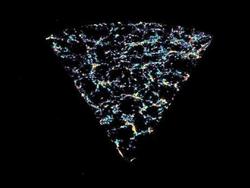
Simulation of large scale structure in the cosmos.
Credit, Pekka Heinämäki .
|
|
|
Active galaxies
|
|
Multifrequency studies of blazars
The blazar research group consists of Elina Lindfors,
Kari Nilsson, Mikko Pasanen, Tuomas Savolainen, Aimo
Sillanpää, Leo Takalo, and Kai Wiik.
The ENIGMA network
The
ENIGMA network is a blazar research network funded
through the European Union Training and Mobility through
Research (TMR) program. The network that started its
operations in November 2002 includes 8 European
institutes doing blazar related research. Two network
meetings were held in 2003: Maysschoss, Germany; 11-14 May
and Portovenere, Italy; 11-15 October.
The first multifrequency campaigns were organized in
autumn 2003 together with the WEBT collaboration (
http://www.to.astro.it/blazars/webt/). The targeted
blazars were 3C 66A (with the RXTE satellite joining the
campaign), AO 0235+164 (XMM satellite) and S5 0716+714 (INTEGRAL satellite). Simultaneous radio,
optical and X-ray lightcurves were obtained during the
campaign periods. The data are currently being
assembled together and analyzed.
During these campaigns we obtained VLBA monitoring
observations of all three targets and optical
lightcurves using the 60 cm telescope on La Palma and
the Tuorla 1 m telescope. The 60 cm telescope has the
rather rare capacity to also measure the polarization of
the source, which we used to monitor the polarization
state of the two brighter objects (3C 66A and S5
0716+714). Preliminary lightcurves can be seen at
http://users.utu.fi/kani/1m/index.html. Preliminary
campaign results can be accessed from the WEBT home
page.
Optical monitoring of the TeV blazars
We have continued our optical monitoring of the
potential TeV blazars from the Costamante & Ghisellini
A&A, 384, 56 list using the Tuorla 1m telescope and the
60 cm telescope on La Palma (see
http://users.utu.fi/kani/1m/index.html for most
recent lightcurves). For many of the selected targets no
previous optical photometry exists. The aim is to
measure their variability properties and select possible
interesting targets for followup studies, possibly
involving also TeV observations. We are also working on
establishing calibration sequences for several of the
fields.
OJ287
Mauri Valtonen has studied the highly variable quasar
OJ287. The currently favoured model for OJ287 is the
precessing binary black hole model of Lehto and Valtonen
(1996) which evolved from the binary model of
Sillanpää et al. (1988). Since these models
were put forward, Hudec et al. (2001) discovered an
outburst of OJ287 in the historical light curve of OJ287
in 1956 which is the second or third strongest ever
recorded in this quasar. Because this outburst is well
off the mean 12 year cycle, it puts strong constraints
on the possible models. In the framework of the
precessing black hole model, it fixes the one remaining
free parameter, related to the properties of the
accretion disk of the primary black hole.
One of the consequences of this discovery is that the
time of the next outburst becomes very well determined.
It should begin on 11 March 2006, add or take a few
days. This is important, and also the original
motivation of this work, because several groups are
interested in the study of this outburst, both from the
ground and from satellites, and time allocations have to
be specific.
In this connection, the setting up and functioning of
the Trinidad telescope for monitoring quasars has been
one of Valtonen's activities in 2003. He has spent
several weeks of his work time (and even more of his
free time) on the St.Augustine campus of the University
of the West Indies. Even though small, the telescope has
advantages in the monitoring work due to its low
latitude, especially during the summer and the evening
and morning twilights.
In the theoretical study of OJ287, the precession of the
accretion disk was calculated. It has the same cycle as
the relativistic precession of the major axis of the
black hole binary. The assumption that the jet of the
quasar is always perpendicular to the accretion disk
leads to the precession of the jet of OJ287, and to the
variation of brightness due to relativistic beaming. It
was demonstrated that the observed brightess variations
in OJ287 in the 60 year cycle are well explained by this
idea.
The work on OJ287 is a collabration with astronomers
from Czech Republic (Rene Hudec and Milan Basta), from
Trinidad (Shirin Haque), from Helsinki University of
Technology (Harri Teräsranta) and from Turku (Harry
Lehto, Aimo Sillanpää and Esko Valtaoja). The
first results were presented in the Sixth Caribbean
Conference on Fluid Dynamics in Trinidad, January 2004.
The cosmic evolution of quasar host galaxies
In collaboration with R. Falomo (Padova), C. Pagani and
A. Treves (Como) and R. Scarpa (ESO), Jari Kotilainen
has studied the host galaxies of quasars at redshifts 1
< z < 2, using near-infrared images obtained at
the ESO VLT UT1 under excellent seeing conditions (~0.4
arcsec). The sample includes radio-loud (RLQ) and
radio-quiet (RQQ) quasars with similar distribution of
redshift and optical luminosity. For all quasars the
global properties of the host galaxy were derived. The
host galaxies of both types of quasars follow the
expected trend in luminosity of massive ellipticals
undergoing simple passive evolution, but RLQ hosts are
systematically more luminous than RQQ hosts by a factor
~2. Comparison with quasar hosts at similar and lower
redshift indicates that the difference in the host
luminosity between RLQs and RQQs remains the same from
z = 2 to the present epoch. No significant
correlation is found between the nuclear and the host
luminosities. Assuming that the host luminosity is
proportional to the black hole mass, as observed in
nearby massive spheroids, these quasars emit at very
different levels with respect to their Eddington
luminosity and with the same distribution for RLQs and
RQQs. Apart from the difference in luminosity, the hosts
of RLQs and RQQs appear to follow the same cosmic
evolution as massive inactive spheroids. The results
support a view where nuclear activity can occur in all
luminous ellipticals without producing a significant
change in their global properties and evolution. Quasar
hosts appear to be already well formed at z~2, in
disagreement with models for the joint formation and
evolution of galaxies and active nuclei based on the
hierarchical structure formation scenario.
Black hole masses and the
fundamental plane of BL Lacertae objects
J. Kotilainen, R. Falomo (Padova), N. Carangelo and
A. Treves (Como) have measured the stellar velocity
dispersion (sigma) from the optical spectra of the host
galaxies of BL Lac objects. Together with the previously
derived photometric and structural properties, these
data are used to construct the fundamental plane (FP) of
the BL Lac hosts. The BL Lac objects follow the same FP
as low redshift radio galaxies and inactive luminous
elliptical galaxies. This indicates that the
photometric, structural, and kinematical properties of
the host galaxies of BL Lac objects are
indistinguishable from those of inactive massive
elliptical galaxies. Using the correlation between black
hole mass (MBH) and sigma in nearby elliptical galaxies,
the masses of the central black hole are derived in BL
Lac objects. These masses, in the range from 60 to 900
million solar masses, are consistent with the values
derived from the bulge luminosity and appear to be
linearly correlated with the mass of the galaxies.
Near-infrared spectroscopy of nearby Seyfert galaxies
J. Reunanen, J. Kotilainen and A. Prieto (Heidelberg)
obtained near-infrared long-slit spectra of nearby
Seyfert galaxies, both parallel and perpendicular to the
ionization cone, and studied the spatial extent of the
line emission, the integrated masses of excited
molecular gas and the excitation mechanisms of
interstellar gas. Large nuclear concentrations of
molecular gas (H2) were found, regardless of the Seyfert
type. The spatial extent of the H2 emission is usually
larger perpendicular to the cone than parallel to it, in
agreement with the unified models of AGN. The size of
the nuclear H2 emission is larger than the predicted
size for molecular torus (1-100 pc). Thus the emission
probably arises from material surrounding the torus
rather than directly from the torus. Broad Br gamma was
detected in nearly half of the optically classified
Seyfert 2 galaxies, including two objects with no
evidence for a hidden polarized broad line region. This
high detection rate stresses the importance of
extinction effects as the main cause for the Seyfert
dichotomy. Nuclear [Fe II] emission is generally
blueshifted which, together with the high Br gamma/[Fe
II] ratios, suggests shocks as the dominant excitation
mechanism in Seyfert galaxies. Bright coronal emission
lines [SiVI] and [Si VII] are detected in ~60 % of the
galaxies. In three galaxies the coronal lines are
extended only parallel to the cone. This could be
explained by a strongly collimated radiation field or,
most plausibly, by shock excitation due to the jet or
superwind interacting with the interstellar medium.
Seyfert - starburst connection in radio continuum
The connection of circumnuclear starburst rings to
Seyfert nuclei is a controversial subject. Does nuclear
activity have an impact on the properties of the ring,
or vice versa, what is the role of the ring in
regulating or even triggering nuclear activity?
Arcsecond resolution VLA radio continuum observations,
obtained by J. Kotilainen and J. Reunanen in
collaboration with S. Laine (Caltech), S. Ryder (AAO),
R. Norris (ATNF) and R. Beck (MPIfR), show clearly the
morphology of circumnuclear emission. Careful analysis
of the radio continuum morphology and flux levels,
together with spectral index information, is crucial for
investigating the interplay (or lack thereof) between
the nucleus and the circumnuclear ring. Search has been
made for radio jets which could trigger star formation
in the circumnuclear ring of gas, and for differences in
the ring properties between Seyfert and starburst
galaxies. Preliminary results suggest that there is no
obvious direct connection between nuclear activity and
star formation in the circumnuclear rings.
|
|
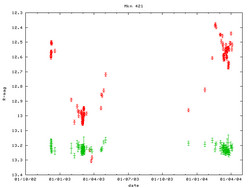
A
recent optical light curve for the BL Lac object Mkn
421. Optical monitoring of the potential TeV blazars
from the Costamante & Ghisellini (Astronomy and
Astrophysics, 384, 56) list using the Tuorla 1m
telescope and the 60 cm telescope on La Palma see
http://users.utu.fi/kani/1m/index.html for most
recent lightcurves). For many of the selected targets
no previous optical photometry exists. Credit: Kari
Nilsson.
|
|
|
Galaxies
|
|
Far-infrared galaxies in the ISOPHOT
Cosmic Infrared Background Project
The ISOPHOT Cosmic Infrared Background (CIRB) project
detected 55 far-infrared sources at multiple wavelengths
between 90 and 180 microns. These sources produce up to
20% of the CIRB detected by COBE, and the high source
counts require models with extreme evolution or unknown
populations. It is thus important to learn their nature
to understand the star formation history of the universe
and the early build-up of galaxies. J. Kotilainen,
P. Väisänen (Univ. Chile), M. Juvela,
K. Mattila and J. Kahanpää (Helsinki) are
conducting an optical, near-infrared and radio imaging
and spectroscopy follow-up to identify these
sources. Initial classification based on optical and
near-infrared colours, interaction properties and
photometric redshifts, confirms previous indications that
a large fraction of these far-infrared sources are local
star forming galaxies, while the rest are galaxy
clusters, or dusty star forming galaxies or obscured AGN
at higher redshifts (z = 1-2).
Distances to galaxies
Pekka Teerikorpi has continued studies on the
extragalactic distance scale, the separate class of
quasars as a cosmological probe, and the theory and
applications of multifluid Friedmann cosmological models.
In collaboration with G. Paturel (Lyon) he has performed numerical
simulations on the new extragalactic Cepheid distance bias which they
discovered in 2002. The simulations show that the bias, for which the
amplitude of Cepheid variations are important, behaves qualitatively
and quantitatively similarly as the bias pattern in the
observations. The identification of this bias may significantly
influence the cosmic distance scale, increasing the distances to
calibrator galaxies and decreasing the inferred value of the Hubble
constant. The work on the actual effect on the distance scale is going
on. A paper by P.T. on the separate class of luminous quasars in
the Hubble diagram showed that the class is as well or even better
visible within the current Lambda dominated cosmologies than within
the previously used Einstein-de Sitter model. This study utilized the
cosmological Malmquist bias approach.
In collaboration with A. Gromov and Yu. Baryshev (St.Petersburg),
Teerikorpi has studied on a phenomenological level multifluid
Friedmann models with different matter and dark energy compositions
with and without interaction and with different equations of state,
both stationary and non-stationary. A useful classification of
cosmological models based on interaction and equations of state was
proposed. In a paper by these authors a special case of models with
interaction, coherent models, were studied. Interestingly, a model was
found which has almost the same Hubble relation (luminosity distance
vs. redshift) as the current standard flat model that well explains
the Hubble diagram of high-redshift supernovae of type Ia.
In collaboration with Yu. Baryshev, Teerikorpi continued writing the
monograph on fundamental questions of practical cosmology, planned to
be completed during 2004.
Distances to galaxies in the extended local group
Rami Rekola
has obtained observations of dwarf elliptical and
irregular galaxies of the extended local group using
the NOT.
Distances to the galaxies are being determined via the
surface brightness fluctuation method (with Helmut
Jerjen, Mount
Stromlo Observatory ). Cepheid based distances for
IC 342, a large, starburst spiral galaxy, are being
determined, using observations with the NOT over a long
baseline (5 years). Planetary nebulae have been used
to make a distance determination to NGC 253 (using
imaging data from the ESO 3.6 metre). This is
part of a longer term program to assemble reliable
masses and distances for the extended local group
galaxies with a view to simulating their dynamics. Many
of these galaxies are at distances where the effects of
"dark energy" on the Hubble flow are first noticable;
accurate distances to the galaxies are therefore of
particular interest.
|
|

Part of the giant spiral galaxy IC 342. It lies
just beyond our own Local Group of Galaxies in
another group called Maffei Group or IC342/Maffei
Group. The image above is a combination of images
taken with BVRI filters (roughly blue, visual =
green, red, and infrared) by Rami Rekola and Kari
Nilsson at the Nordic Optical Telescope.
|
|
|
Very long baseline interferometry
|
|
In 2003, Tuorla VLBI group (Wiik, Savolainen and
Valtaoja) carried out several large observing campaigns
using the NRAO's Very Long Baseline Array (VLBA) - a
10-element highly efficient instrument dedicated to very
long baseline interferometry.
45 hours of observing time was used for multi-frequency
polarimetric monitoring of the pc-scale jet of the
nearest quasar 3C 273, which was also a target for the
INTEGRAL gamma-ray satellite. The data obtained with the
VLBA are of excellent quality and the multi-frequency
approach is providing interesting results of the
spectral evolution of the jet's emission regions. From
the VLBA data it is also possible to deduce limits for
several physical parameters (e.g. the Lorentz factor and
the Doppler factor), which will be used for the
interpretation of the INTEGRAL observations.
The group also participated in two other
INTEGRAL-related projects besides 3C 273. 3C 279 was
observed twice with the VLBA during 2003 and one more
observation will take place in early 2004. This blazar
was clearly in a low state of activity during last year,
but INTEGRAL still managed to obtain a detection of
it. As a large multi-wavelength campaign was organized
for this source, it was possible to reconstruct the
spectral energy distribution of the quiet state of a
blazar. Interpretation of these results will be
interesting and the obtained VLBI data are utilized in a
similar way as with 3C 273.
A highly active intra-day variable blazar 0716+714 went
through a major outburst in late 2003 and it was
observed with the INTEGRAL for 500 ksec. At the time,
the source was also a target for intensive radio-optical
monitoring performed with the Whole Earth Blazar
Telescope (WEBT). The Tuorla VLBI group proposed
target-of-opportunity observations with the VLBA and
they were granted with 10 hours of observing time, which
was executed immediately. Also the proposed follow-up
project was approved by the VLBA scheduling committee
and thus the group will continue to monitor 0716+714 in
2004.
Another source which experienced a major flare in 2003,
was 0420-014. The group managed to get exploratory time
from the VLBA to image the source during the
outburst. The analysis of the data is in progress.
In addition to activities described above, the group
also participated in two WEBT-related observing
campaigns, which are still running. 72 hours of
observing time was obtained from the VLBA to carry out a
multi-frequency polarimetric monitoring of an
intermediate BL Lac object 3C 66A together with the
WEBT, the RXTE-satellite and ground based Cherenkov
telescopes. A total of 135 hours of observing time was
granted to a similar project targeted to a BL Lac object
AO 0235+164, a source which is possibly showing a 5-year
period in its optical light curve. The monitoring will
continue in 2004 and it will hopefully see the predicted
outburst.
The group finished the reduction of the data from its
gigahertz-peaked spectrum sources project, which was
done in collaboration with the Metsähovi radio
observatory. The results are to published in 2004.
|
|
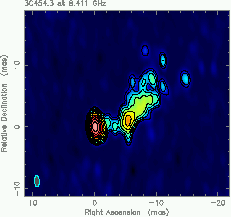
VLBA image of 3C454.3 at 4 cm. This source was used
as a calibrator in the Tuorla-Metsähovi
Gigahertz Peaked Spectrum (GPS) project. Although
only 10 minutes of the granted 18 hours of total
observing time was spent for this particular source,
it was possible to make this rather high quality
image during the preliminary inspection of the
dataset. Credit: Kaj Wiik.
|
|
|
Dark Matter
|
|
Dark Matter as black holes
Jyrki Hänninen and Chris Flynn completed a numerical
study of the orbits of stars in the disk of the Galaxy by
masive black holes (dark matter) and giant molecular clouds.
The work is a follow up of a study of the effect of such dark
matter and clouds on stars in the Solar Neighbourhood. In the
new work, the effect of these gravitational perturbers has been
studied for disk stars from the inner to the outer disk, and
the results compared to observations of the velocity dispersion
of disk K giants over a wide range of Galactocentric radius. We
conclude that black holes can be coaxed into reproducing the
observed velocities of the disk giants from the inner to the
outer disk; in other words they remain a possible but somewhat
unlikely source of disk heating. The figure shows a patch of
the Galactic disk, seen close to edge-on, and surrounded by
massive balck holes.
Dark Matter as white dwarfs in a Galactic "shroud"
Part of the solution to this so-called "dark matter problem"
would be that there are a lot of very dim stars out there which
we have yet to detect with our telescopes. A very thick disk of
stars , "shrouding" the galaxy's disk, has been proposed as a
solution to the problem.
If such a shroud of stars actually envelopes the Galaxy, then
the stars must be very faint in order never to have been seen
before; the best candidate for these stars are the so-called
"white dwarfs", stars which have run out of fuel and are slowly
cooling away to near invisibility. Whether the proposed shroud
could be made of such stars has now been addressed by Janne
Holopainen and Chris Flynn at Tuorla Observatory by creating a
model of the distribution of the low-mass stars around the Sun,
including the colours, luminosities and space motions of the
stars. They compared their model to two very large surveys of the
fastest moving and faintest detectible stars on the sky. The team
concluded that, although a few quite interesting stars have
turned up in these two surveys, practically all the observations
are well understood in terms of our present knowledge of the
Milky Way. Furthermore, they were able to put strong constraints
on how bright the putative white dwarfs could be before
significant numbers of them would have been detected in the
surveys; the results indicate that the white dwarfs must be very
faint indeed to have avoided detection. But there is still hope
forwhite dwarfs; they need only be a bit dimmer than the limits
of the existing surveys to have been missed. New large surveys
are being planned and may yet find them, if they are there.
Disk surface mass density determination
The thickness of the Milky Way's disk is a balance between the
total gravity of all the stars in it, and how fast they are
individually moving. A given star, moving with a certain speed
near the Sun, will rise upwards through the surrounding disk
stars until the total gravity of all the stars below it pulls it
back down again.
To measure the amount of matter above and below the Sun in the
Galactic disk, Chris
Flynn of Tuorla
Observatory and Johan Holmberg of Lund Observatory have used
data from the European Space
Agency's Hipparcos
satellite on so-called K giant stars. These stars
are cooler but much brighter than the Sun; indeed, the Sun is
expected to become a K giant itself some 5 billion years from
now.
The Hipparcos
satellite measures very accurately the distances and speeds
of nearby K giant stars; the research team have applied these
measurements to much more distant K giants directly 'above' the
Sun (i.e. perpendicular to the Milky Way disk) in order to
determine accurate distances to these stars too. The data they
used was first collected in the mid-1980's using a 100 year old
brass and clockwork 5 inch telescope on Mount Stromlo
Observatory, the Oddie Telescope (sadly destroyed along with all
the other telescopes in the bushfire which swept over Mount
Stromlo in January 2003). It wasn't until now that the results of
the Hipparcos
satellite could be utilised to measure the
distances to the stars with real precision.
Their new results confirmed their analysis from almost 20
years ago: the thickness of the disk is exactly what is expected
if only the visible matter contributes to the Galactic
potential. There is no need to invoke putative dark matter in the
Galactic disk.
|
|

Disk dark matter. Distribution of red giants
perpendicular to the Milky Way disk. The plot shows
the number of K giant stars above the Sun seen in a
survey taken with telescopes at Mount Stromlo
Observatory. The curve shows the expected number of
stars based on a theoretical computation using the
gravitational attraction of all the known stars around
the Sun; it is a very good match to the data.
|
|
|
Stars
|
|
White dwarfs 'with molecular spectral features'
Using the ALFOSC 'in spectropolarimetric mode' on the
Nordic Optical Telescope, Svetlana Berdyugina (Astronomy
Division, University of Oulu, Finland), Andrei Berdyugin
and Vilppu Piirola (Tuorla Observatory) have studied a
sample of very cool, helium-rich white dwarfs whose
atmospheres are enriched with carbon. Optical spectra
of these stars are dominated by broad bands of molecular
carbon C2. One of the stars, G99-37, is known to be a
unique white dwarf which in addition to the C2 bands
shows the strong CH band. Previous spectropolarimetric
observations obtained with very low spectral resolution
revealed that the star possesses a strong magnetic
field, of the order of 1 MG. The new observations with
the ALFOSC confirmed the remarkable circular
polarization signal in the CH band with much higher
spectral resolution. In addition, the violet CN band was
identified for the first time in a white dwarf. In
contrast to the C2 bands and similar to the CH band, the
CN band shows significant circular polarization. The
discovery of the CN band in a white dwarf implies that a
significant amount of nitrogen was brought to the
surface from the stellar core. This may provide an
estimate of the mass of a progenitor star. Also, up to
now the CN molecule was not observed at magnetic field
strengths of 1 MG, and this presents a serious
interpretive challenge for molecular physics.
Interstellar polarization at high galactic latitudes
from distant stars
In collaboration with V. Piirola and P. Teerikorpi,
Berdyugin compiled a detailed map of interstellar
polarization for the South Galactic Pole (b <
-70 degrees). The map is based on new polarization
measurements of 183 stars of spectral classes from A
to K at distances up to 500 pc. These stars were
observed with with the 2.6 m Nordic Optical
Telescope (La Palma), the 60 cm KVA telescope (La
Palma) and the 2.15 m Jorge Sahade telescope (CASLEO
Observatory, El Leoncito, Argentina) in 2001-2003.
We use polarization data to investigate the
distribution of dust and to map the Galactic
magnetic field at high southern galactic latitudes
and make a comparison with the opposite northern
polar zone. In general, the magnetic field is
smoother in the south and aligned with the global
pattern. There are no such extended dusty structures
here as Markkanen's cloud in the north. Another
interesting finding is the indication for larger
extent of the dust layer in the South Galactic Pole
direction.
Interacting binary W Serpentis
Berdyugin, Piirola and Mikkola have studied the active interacting
binary W Ser. Polarimetric and photometric monitoring of the star
carried out in June-July 2001 revealed phase-locked variations of
polarization with the amplitude of about 0.8 % accompanied by large
(more than 50 degrees) variations in polarization angle. The following
observations, obtained in August 2002, revealed the noticeable changes
in amplitude and shape of the variability curve. Moreover, as we
found, the latest ephemeris published in literature is not valid any
more. Due to very high mass exchange rate the orbital period is
changing. Combining new photometric data with the data published for
the last 80 years, we have derived a new improved ephemeris. In June
2003 we have conducted a polarimetric monitoring of W Ser primary
eclipse on the NOT with the Turpol. We detected the rapid change of
the polarization angle seen through the phase range -0.15 - 0.15. It
happens due to eclipse of the accretion disk and primary star by
secondary component. Detailed modelling of this eclipse will allow to
estimate the size of the disk as well as the size of the components.
Monitoring of cataclysmic variables
Lehto and Katajainen have continued their monitoring
campaing on cataclysmic variables (CV). They have
used the Tuorla Observatory 0.7 m Schmidt telescope
with a ST-8 CCD. The aim of the monitoring, which
began in 2002, is to cover long term variability of
magnetic cataclysmic variables (mCVs), polars and
intermediate polars. The long term variations,
i.e. high and low states, occur unfrequently and
unpredictable. The different states are related to
the thermal balance of the secondary star and the
refilling of the Roche lobe, but the detailed
physics behind these phenomena are still largely
unknown. Long term monitoring of mCVs are needed
also to measure accurately the ephemeris of the WD
spin (to an accuracy of 10-9 days or
better) and of the orbital period. To do this we
need light curves spread over several years. About
20 polars and intermediate polars are monitored
regularly.
Lehto and Katajainen also collaborate in CV studies
with Dr. Andy Norton at the Open University (Milton
Keynes, UK), and with Dr. P. Hakala (Observatory,
University of Helsinki).
X-ray binaries
Lehto and Dr. Emilios Harlaftis, from Athens,
Greece have been studying X-ray binaries. Regular
monitoring of 28 X-ray binaries with the Nancay
decimetric radiotelescope began in February 2003,
and has continued since on a weekly basis. The
analysis of the 2003 data is in progress and is
carried out in collaboration with Mr. Sakari
Nummila. This is now the largest database of radio
variability of a sample of X-binary sources
containing a black hole or a neutron star. It is by
itself a very unique and useful data set and can be
used to bridge the connection between radio
emission and other properties of these systems,
eg. type of primary, and type of variability
observed in other electromagnetic bands. These
observations were initiated in support of the
forthcoming EVN observations which are done in
collaboration with Dr. Anthonis Polatidis, Bonn.
The primary aim of these studies is to understand
the kick recieved by the X-ray binary during the SN
I explosion of the primary component and to compare
the spatial velocity distribution of X-ray binaries
to X-ray pulsars.
Lehto and Harlaftis in collaboration with
Drs. Pierre Colon, Eric Gerard and Jean-Michel
Martin from Paris Observatory, Meudon, and Nancay
Radio Observatory have studied GRS1915+105 in a
large international ToO campaign. High level of
variability was observed. The analysis of this data
combined with other radio data from RATAN, MERLIN
and Ryle telescope data is in progress.
Lehto, Katajainen in collaboration with Dr. Boris
Gäsicke from Southampton, UK have been
monitoring several new possible magnetic variables.
Lightcurves were obtained in white light with the
70 cm Schmidt Camera of Tuorla Observatory.
K dwarfs
Kotoneva has been working in collaboration with
the scientists at York University, Toronto. The
main interest has concerned "Kapteyn's star". This
star is one of our most interesting stellar
neighbourhood, e.g. its proper motion is very
large and it is one of the few stars with
retrograde stellar orbit. We have observed the
IR-spectrum of the star in order to compare it
with the synthetic spectra (so called NextGen
models). Also theoretical Galactic simulations
have been run to explain reasons for its peculiar
spectrum as well as its strange orbit.
In 2002 Eira Kotoneva completed a study of the
metal composition of a large uniform set of K
dwarf stars in the European Space Agency's
Hipparcos satellite in order to make a very
precise measurement to be made of the distribution
of ``heavy'' elements (i.e. elements heavier than
Helium) in a representative sample of stars near
the Sun. This is a major constraint on models of
the evolution of galaxies, and can be used
inderectly to constrain the density of matter
(dark or otherwise) near the Sun. The work has
been extended to spectral analysis of many of the
stars in a collaboration with National
Astronomical Observatories of China, part of the
Chinese Academy of Sciences; high resolution
spectra were obtained by Kotoneva; effective
temperatures, surface gravities and abundances for
a wide range of elements are currently being
computed. These data will probe the nature of
chemical enrichment in the Galaxy using K dwarfs
for the first time; accurate abundances for K
dwarfs will also be very useful for constraining
the production of Helium over successive stellar
generations (as described below).
Production of Helium
Chris Flynn, in collaboration with Raul Jimenez of the
University of Pennsylvania; James MacDonald of the
University of Delaware and Brad Gibson of Swinburne
University of Technology have used data from the
European
Space Agency Hipparcos
satellite and so-called K dwarf
stars to measure the production of Helium in the
cosmos. These stars are cooler and fainter than the Sun
and are essentially stellar fossils. They have changed very
little of their initial supply of hydrogen into helium
during their long lives; in other words the hydrogen,
helium and heavy elements we see in them today is they same
as when they were born. We can follow the production of
helium and heavy metals with a set of these stars. The
Hipparcos
satellite measures very accurately the
real energy output of these stars. The research team have
used computer calculations to predict how brightly such
stars should shine depending on how much hydrogen, helium
and heavier elements they contain. Measuring the amount of
heavier elements using telescopes can be done very easily
-- it is the amount of helium in stars which has been very
difficult to measure. Now, the comparison of the model
computations with the real stars reveals, indirectly, the
amount of helium they contain.
The team have
found that over the billions of years since the Universe
was born, stars have produced just about exactly twice as
much helium as everything else. Stars are primarily helium
factories!
We are now intensively following this work up at Tuorla
Observatory. PhD student Luca Casagrande will obtain phtometry for a
carefully selected set of K dwarfs with accurate
metallicities; straightforward observations will triple
the size of the basic sample and lead to an improved
measure of the Helium production rate.
|
|
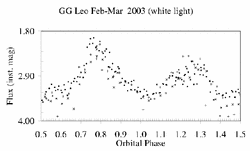
Light curve of the polar GG Leo (V=17-18) over
one 79.7 min orbital cycle (from phase 0.5 to 1.5)
observed in Tuorla 2003. Larger image
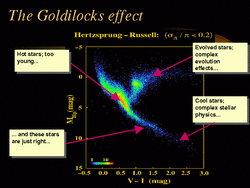
The Goldilocks effect. K dwarf stars have been
used to measure the amount of Helium which has been
produced via fusion in stellar cores over cosmic
time-scales.
|
|
|
The Sun
|
|
Solar activity
N.B. More on the latest work of the solar group can be
found here.
The study of solar variations from solar
minimum to maximum continued by analysis of
energetic particle fluxes of 1996-2001. The study
included listing of solar energetic particle
events, analysis of anomalous cosmic rays, and
comparison of energetic particle fluxes
vs. sunspot number and number of flares. The
results show that the current solar cycle
(cycle23) is less active in energetic particle
production than cycles 21 and 22. Also the
minimum of solar energetic particle fluxes in
1996-97 was deeper and longer than the minimum of
sunspot number, but the activity increased in
1998 faster. In 1999 the increase in particle
fluxes stopped, but the sunspot number increased
continuously. All forms of solar activity reached
their maximum during the years 2000-01. Due to
the improved instruments it was for the first
time possible to study anomalous cosmic rays at 1
AU from solar minimum till the maximum. The
studies showed a rather smooth decrease of
intensities during 1996-2001.
Energetic solar particles
Solar cosmic-ray studies remain as the main field of
research at the Space Research Laboratory (SRL). The ERNE
(Energetic and Relativistic Nuclei and Electron)
experiment on the SOHO spacecraft continued trustworthly
to provide observations of solar energetic particles
(SEPs) associated with solar flares and coronal mass
ejections (CMEs). Within the Väisälä
Institute of Space Physics and Astronomy (VISPA)
co-operation with Tuorla Observatory to advance common
research of current problems in astrophysics and space
science has continued during 2002-2003.
Recently improved anisotropy measurements of high-energy
protons with ERNE have allowed a discovery of a kind of
interplanetary "highway" for solar energetic
particles. The ERNE has measured the proton flux
anisotropy during the 2-3 May 1998 SEP event, when SOHO
was inside a magnetic cloud associated with a previous
CME. During most of the first four hours of the SEP event
the proton intensity parallel to the magnetic field was
~1000 times higher than in the perpendicular
direction. The ERNE observations indicate that the
magnetic flux-rope structure of the CME provides a
"highway" for transport of solar energetic protons with a
parallel mean free path of at least 10 AU. The SEP
anisotropy observed in the solar wind at 1 AU may be
related to processes of the solar wind acceleration,
because those processes also load the solar wind with the
turbulence that scatters SEPs. There is increasing
evidence that acceleration of the normal solar wind is a
result of the reconnection of open magnetic flux with
coronal loops. If so, our observations may indicate that
the closed flux of the magnetic rope has experienced much
fewer reconnections than the open flux of normal solar
wind, and for this reason there are fewer small-scale
irregularities within CMEs from which to scatter
high-energy protons.
SEP observations of the ERNE instrument enable measurements of the
isotope 3He in the high-energy range >15 MeV/nucleon, with a good
statistical resolution. We have surveyed the ERNE observations for the
period from 8 February 1999 to 7 December 2000. A histogram of the
daily 3He/4He abundance ratio revealed a common overabundance of
3He. We consider the 3He overabundance as a signature of impulsive
processes, which seem unavoidable during the development of the
SEP-productive solar eruptions comprising CMEs and flares. The ERNE
registered also less frequent 3He-rich events with super high
enhancements of 3He/4He. These high-energy 3He-rich events make up a
new kind of hybrid events, possessing the impulsive-type composition
and the gradual-type time-profiles. This group of solar particle
events has not been identified in earlier observations. We have
developed the first theoretical model of interplanetary reacceleration
of 3He that explains main properties of the new group of solar
particle events. Our numerical simulations suggest that appearance of
3He in the unusually high energy range can be caused by a
reacceleration of ~1 MeV solar ions in oblique shocks or compressions
driven by not very fast CMEs associated with those events.
The study of solar variations from solar minimum to maximum continued
by analysis of energetic particle fluxes of 1996-2000. The study
included listing of solar energetic particle events, analysis of
anomalous cosmic rays, and comparison of energetic particle fluxes
vs. sunspot number and number of flares. The results show that the
minimum of solar energetic particle fluxes in 1996-97 was deeper and
longer than the minimum of sunspot number, but the activity increased
in 1998 faster. Also in 1999 the increase in particle fluxes stopped
but continued in sunspot number.
Theoretical research at SRL included the experiment-oriented modelling
of the SEP acceleration in solar corona and subsequent propagation in
the interplanetary medium to 1 AU. We have performed the first
modelling of SEP events inside corotating compression regions (CIRs). A
trap-like structure of the interplanetary magnetic field modifies the
SEP intensity-time profiles, energy spectra, and anisotropy. The
numerical model forms a basis on which to interpret SEP observations
made by present and future spacecrafts at the longitude-dependent
speed of solar wind. The modelling results are similar to the patterns
observed with the ERNE in August 1996. In the high-energy proton
anisotropy data, we have revealed a signature of the CIR-associated
magnetic mirror, which is already formed at 1 AU and can locally
accelerate low energy ions typically observed inside CIRs, in contrast
to the previously assumed acceleration exclusively at > 2 AU from the
Sun.
The energetic particle observations can give valuable constraints on
the models of coronal heating and acceleration of solar wind by plasma
waves. This is because precisely the same waves that heat and
accelerate the solar wind plasma, also influence the propagation of
energetic particles through the corona and interplanetary medium. The
group has initiated separate studies on solar wind heating in parallel
with the energetic particle studies. On the other hand, the modelling
of the cyclotron wave heating and acceleration of the solar wind
allows to compute the mean free path profiles of solar energetic
particles, which can be used for modelling the diffusive shock
acceleration near the Sun. The first theoretical results indicate,
however, that more efforts are needed to bring consistency between the
SEP observations and the models of solar wind. For this purpose, the
SRL group turned its attention to turbulent cascading of the wave
energy, which has such capabilities. It was found that the
interplanetary transport could be brought closer to the observed one,
while the acceleration would still be possible in the
corona. Currently, a more consistent description of the cascade is
under development. These studies have been conducted in co-operation
with Ruhr-Universität Bochum, Germany, under the Academy of Finland
and Deutscher Akademischer Austausch Dienst (DAAD) -funded project
"Collective Processes in Astrophysical Plasmas: Waves, Heating, and
Accelerated Particles".
The SRL participated in the Space Weather for Antares Program (SWAP),
funded by the ANTARES programme of the Academy of Finland. The goal of
the program was to improve the understanding of space weather effects
and their predictability. SRL participated in the research by studying
the energetic particle production and transport related to the
potentially geoeffective CMEs, using both observations from ERNE and
other space-borne instruments, and theoretical considerations.
The primary goal was to seek connection between the strength of the
potentially resulting geomagnetic storm, and the energetic particle
signatures of the solar-terrestrial events, those being SEPs,
accelerated at the Sun, and the energetic storm particles (ESPs),
accelerated locally at the CME-driven shock front. It was found that
the time-difference of the onsets of these two features,
representative of the CME transit time, correlates well with the storm
strength. As the ESP onset occurs typically around 5 hours before the
shock arrival to the observing spacecraft, the ESP can be used as an
early warning mechanism of a geoeffective event.
The research was continued with studies of the ESP events by comparing
the properties of the ESP time profiles to the theoretical
predictions, in order to obtain further information of the approaching
CME. In particular, it was of interest to see whether the state of the
ambient background plasma, the solar wind, could be used with the ESP
observations in estimating the CME properties. The preliminary results
show correlation between the storm strength and the deviation of the
observed properties from a simple theoretical model. The refinement of
the observations and the theoretical considerations is underway.
The work with building the Alpha Magnetic Spectrometer (AMS) phase II
detector continued at the Space Research Laboratory. Since the AMS-I
test flight in 1998, the main emphasis at SRL has been the
co-ordination of the Finnish industry activities for AMS-II
construction. The flight design of AMS-II phase detector was fixed
during 2003 and the detector is planned to have a three-year flight on
International Space Station starting on late 2005.
Collective processes in astrophysical plasmas
The "Collective Processes in Astrophysical Plasmas: Waves,
Heating and Accelerated Particles" (COPAP) project
continued for the second year in 2003. The project is a
collaboration between researchers in VISPA (R. Vainio,
T. Laitinen, J. Virtanen, and E. Valtaoja) and
Ruhr-Universität Bochum, Germany, and it is aimed at
the modelling of the solar wind and of particle
acceleration at the Sun, and transferring this knowledge
to the modelling of relativistic jets.
Vainio, Laitinen and Fichtner (2003) studied wave-wave interactions in the
solar wind. They developed a simple analytical model that describes the
erosion of the wave spectrum as a result of these interactions during
the wave propagation outwards from the Sun. The model was shown to have
potential use in the modelling of coronal heating and solar wind
acceleration. In addition, Laitinen and Vainio (2003) applied the model
to calculate the mean free path of solar energetic particles from the
solar corona out to the interplanetary medium, and applied this mean
free path to the modelling of particle acceleration in a coronal shock
wave. They demonstrated that these scattering conditions yield efficient
particle acceleration at shocks propagating quasi-perpendicular to the
mean field.
Vainio, Virtanen and Schlickeiser (2003) studied the
transmission of Alfven waves through relativistic shock
fronts, and demonstrated that this process can lead to
extremely efficient acceleration of particles in
relativistic jets: electron spectral indices close to
unity, corresponding to flat synchrotron spectra can be
obtained at jets with large Alfven speeds and magnetic
fields nearly aligned with the shock normal upstream of
the shock front (in shock frame). This result may allow us
explain, e.g., the emission from flat-spectrum radio
sources as synchrotron emission of shock accelerated
electrons.
Solar eruptions
Solar flare and coronal mass ejection studies were
continued in collaboration with the Paris Observatory in
Meudon, France (S. Pohjolainen and N. Lehtinen at VISPA,
N. Vilmer, L. van Driel-Gesztelyi and P. Demoulin at
LESIA) and several other institutes that provide solar
eruption data or take part in the analyses. The funding
agencies included Väisälä Foundation, CIMO,
and EGIDE (France). J.I. Khan took part in the project
during his visiting Academy Fellow post in 2002-2003 at
VISPA. The project aims at understanding eruption
mechanisms, which can be analysed in detail using
multi-wavelength flux and imaging data especially in
radio, EUV, H-alpha, and X-rays.
Enhanced temperature regions
Alexandr Riehokainen in collaboration with
Esko Valtaoja and Silja Pohjolainen made a comparison between the
CaII(k3), H(alpha), SOHO/MDI and radio enhanced temperature regions of the
Sun. It was found that the radio maximum coincides either with the
brightest CaII(k3)/H(alpha) and strongest magnetic field structures within
the ETR area, or with a density enhancement of the less bright CaII
(k3)/H(alpha) and less strong magnetic field structures. Thus it was shown
that ETRs are connected with the chromospheres structures. Role of the
coronal hole for ETRs existence is still unknown.
Some session of solar radio observations were carried out
on the Metsähovi radio telescope at 37 GHz during
July - October 2003. Using data obtained from these
observations it is possible to study some important
characteristics of the weak radio enhanced temperature
regions such as lifetime, brightness and flux
variations. Another goal of this study is investigating of
the solar coronal holes at millimetre radio waves.
Solar oscillations
In November 2003 a new study devoted to the solar oscillations was
started. The first result of the group (article in preparation)
showed that the power of the 3 minutes oscillations variates with
solar cycle. This result was obtained using Nobeyama radio heliograph
data from 1992 - 2002.
|
|
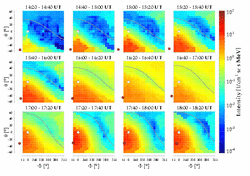
Development of the directional proton intensity in the
energy range 17-22 MeV observed with ERNE/HED in
successive 20-minute subintervals on 2 May 1998. The ERNE
instrument axis is in a frame centre. The Sun is shown as
a white circle with dot. WIND/MFI magnetic field direction
is indicated by a white crossed red circle. Directions
perpendicular to the magnetic field are mapped as gray
curve. Larger image
|
|
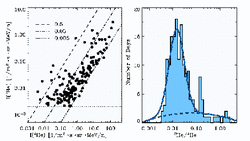
Scatter plot of 3He intensity vs. 4He intensity on 3He event days (in
the energy channel 15-30 MeV/n) and the corresponding day-number
distribution over the abundance ratio 3He/4He. The vertical line in
the left panel represents the minimum limit above which all 4He
enhancements are associated with 3He. The fitted curve in the right
panel reveals a main peak and a high-abundance tail in 3He/4He.
Larger image
|
|
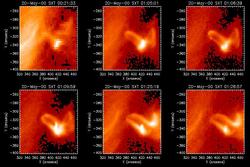
Yohkoh soft X-ray images of a region that produced
repeated flaring in radio and X-rays. The analysis of EUV,
H-alpha, radio, and X-ray images together with magnetic
field information indicated that the flaring was due to
loop-loop interactions. Credit : S. Pohjolainen. Larger image
|
|
|
Astrobiology
|
|
|
The first Finnish astrobiology meeting "Astrobiology in Finland" was
organized by Harry Lehto and Kirsi Lehto (Biology and Plantphysiology
Laboratory, Department of Biology, University of Turku). About 15 invited
scientists and 55 others scientists and students attended the two day
meeting held in May 2003 at University of Turku. This was also the founding
meeting of the Finnish Astrobiology Network (FAN) set up to promote
collaboration between scientists involved in astrobiology. Students
are also encouraged to join FAN. Seven FAN newsletters were issued during
the year. In November 2003, Finland joined the European Astrobiology
Network Association (EANA) with FAN representing Finnish astrobiologists
and Harry Lehto as the national representative in EANA.
|
|
|
|
Theses obtained in 2003
|
|
|
Doctoral dissertations
Alexandr Riehokainen:
Weak Radio Enhanced Temperature Regions at High and Low Solar Latitudes
Viatcheslav Koblik: Solar Sail Motion in near-sun Regions
Timo Laitinen: Energetic Particle Acceleration and Transport in Wave-Heated Solar Wind
Ramon Brasser: Aspects of Solar System and Three-body Dynamics
Tero Sahla: Analysis of Directional Distributions of
Solar Energetic Particles Detected by SOHO/ERNE
Master's theses
Mikko Ranta
|
|
|

|
